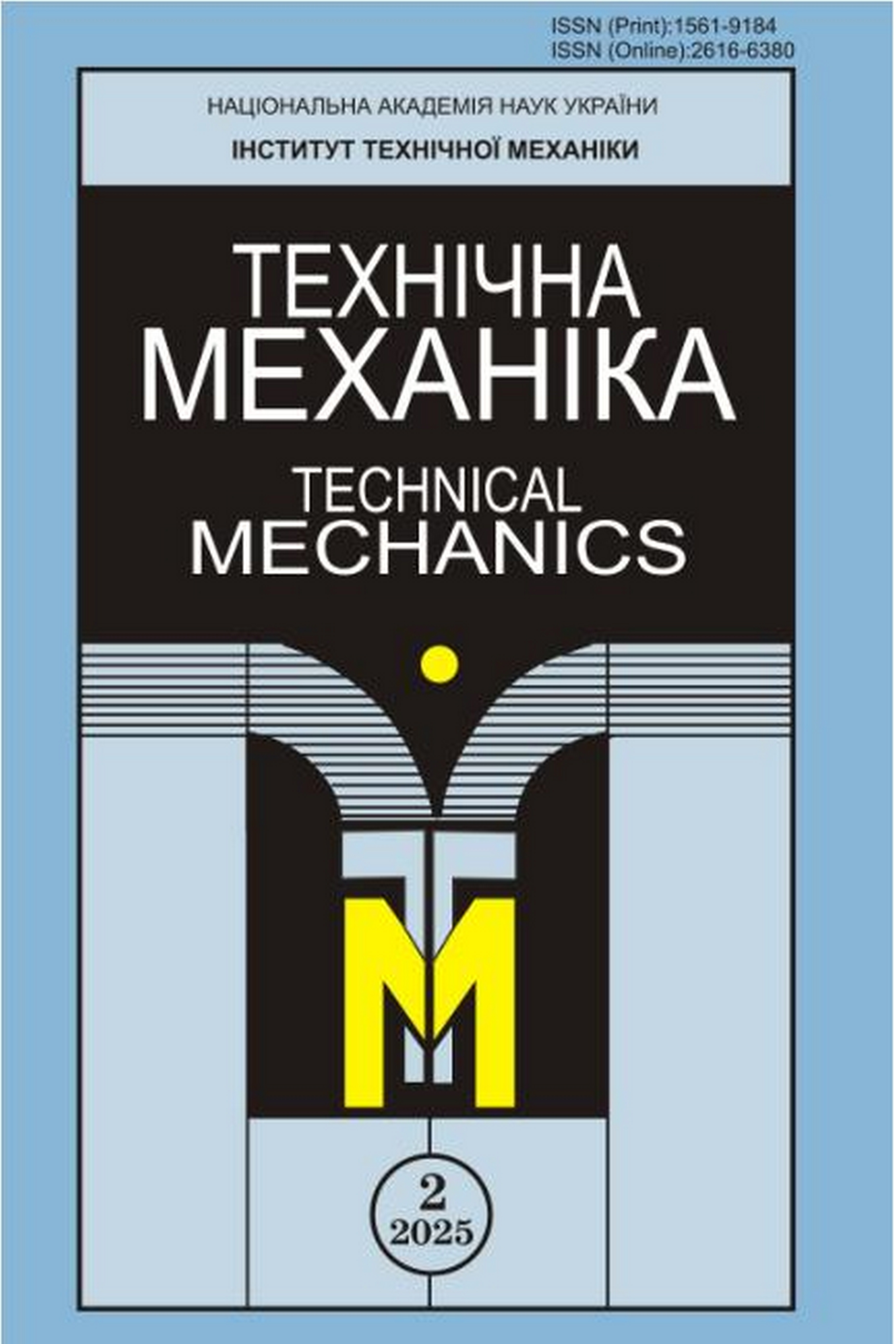ОСОБЛИВОСТІ РОЗВИТКУ АКУСТИЧНИХ КОЛИВАНЬ ПРОДУКТІВ ЗГОРЯННЯ В КАМЕРАХ ЕНЕРГЕТИЧНИХ УСТАНОВОК ПРИ ВИКОРИСТАННІ КОМПОНЕНТІВ ПАЛИВА З МІСЯЧНИХ РЕГОЛІТІВ
Ключові слова:
твердопаливна енергетична установка, стійкість робочого процесу, вихроутворення потоку продуктів згоряння, акустика камери згоряння, агломерація та згоряння металевих добавок палива.Анотація
DOI: https://doi.org/10.15407/itm2025.02.003
Удосконалення робочих процесів в камерах згоряння різноманітних енергетичних установок (теплоенергетичних та суднових установок, авіаційних і ракетних енергетичних установок) традиційно проводиться по ряду напрямків. Забезпечення термо-акустичної стійкості енергетичних установок на їх робочих режимах є одним з важливіших умов ефективного функціонування камери згоряння. Інноваційне використання місячних ресурсів на місці (in situ) є технологією, що припускає значне прискорення темпів освоєння космосу. Очікуване наступним часом зростання активності з дослідження поверхні Місяця підвищує інтерес до місцевих місячних ресурсів, особливо до тих, що використовуються для виробництва компонентів палива з матеріалів Місяця – таких, як магній та алюміній, які в достатній кількості присутні в місячному реголіті. Основна увага приділяється оцінкам принципового здійснення даних проєктів та надійності використання вказаних металів в якості основних видів палива в ракетних енергетичних установках (на основі твердого або ж гібридного палива), спеціально розроблених для реалізації місячних місій. Проте до останнього часу зостаються значні прогалини в розумінні того, як ці метали будуть вилучати з реголіту, інтегруватися в паливну частину камери енергетичної установки, які при цьому будуть підсумкові термодинамічні та інші характеристики енергетичних установок, ураховуючи погане змішування та неповне згоряння палива.
Відомо, що найбільш критичні умови роботи ракетних енергетичних установок твердого палива часто пов’язані з розвитком небезпечних динамічних процесів, які характеризуються наднормативними величинами режимних параметрів. Використання палива з місячного реголіту може призвести до недопустимих стрибків тиску та різкого зростання локальної температури продуктів згоряння, що можуть призводити до порушення міцності та руйнування конструкції камери згоряння ракетних енергетичних установок, переходу на критичний режим роботи ракетної енергетичної установки, аж до згасання процесу горіння палива в такій енергетичній установці. Проведено чисельне визначення термодинамічних характеристик енергетичної установки, що використовує таке металізоване паливо, яке за характеристиками близьке до речовин, отриманих з місячного реголіту, а також виконано попередній аналіз експериментальних та розрахункових параметрів акустичних автоколивань (тяги, динамічних складових тиску, осьової швидкості) та показано розвиток процесу вихроутворення потоку продуктів згоряння в камері енергетичної установки.
ПОСИЛАННЯ
1. Universe SpaceTech. Лунный модуль Blue Ghost от Firefly Aerospace готов к старту. Интернет ресурс URL: https://universemagazine.com/ru/lunnyj-modul-blue-ghost-ot-firefly-aerospace-gotov-k-startu/ (Last accessed 20.02.2025).
2. Firefly Aerospace. Blue Ghost Mission 1. Firefly's first mission to the Moon launched on January 15 and will land on March 2. URL:https://fireflyspace.com/ (Last accessed 20.02.2025).
3. Sowers G. A cislunar transportation system fueled by lunar resources. Space Policy. Vol. 37. Part 2. 2016. P. 103–109. https://doi.org/10.1016/j.spacepol.2016.07.004
4. Hayne P., Hendrix A., Sefton-Nash E., Siegler M., Lucey P., Retherford K., Williams J.-P., Greenhagen B., Paige D. Evidence for exposed water ice in the Moon’s south polar regions from Lunar Reconnaissance Orbiter ultraviolet albedo and temperature measurements. Icarus. 2015. Vol. 255. P. 58–69. https://doi.org/10.1016/j.icarus.2015.03.032
5. Kinefuchi K., Miyakita T., Umemura Yu., Nakajima J., Koga M. Cooling system optimization of cryogenic propellant storage on lunar surface , Cryogenics. 2022. Vol. 124. 15 p. https://doi.org/10.1016/j.cryogenics.2022.103494
6. Yelken U., Yalcintas A., Karabeyoglu A. Development of a Lunar Vehicle with a Hybrid Rocket Engine Produced Using Lunar Resources. International Journal of Aeronautical and Space Sciences. 2025. V. 26. Pp. 1050 - 1058. https://doi.org/10.1007/s42405-024-00809-2
7. Hampl S., Austen D., Van Ende M.-A., Paleka J., Goroshin S., Shafirovich E., Bergthorson J. Conceptual design of rocket engines using regolith-derived propellants. Acta Astronautica. 2024. Vol. 223. P. 594–605. https://doi.org/10.1016/j.actaastro.2024.06.029
8. Xanthopoulou G. Development of new processes for in-situ resource utilization (ISRU) on Moon and Mars. Космічні дослідження і технології. 2013. №01. P. 24–31. URL: https://www.researchgate.net/publication/236684254 (last accessed 20.02.2025).
9. Schreiner S., Dominguez J., Sibille L., Hoffman J. Thermophysical Property Models for Lunar Regolith. Advances in Space Research. 2016. V. 57. Iss. 5. Pp. 1209 - 1222.
https://doi.org/10.1016/j.asr.2015.12.035
10. NTRS - NASA Technical Reports Server. Powdered aluminum and oxygen rocket propellants: Subscale combustion experiments URL: https://ntrs.nasa.gov/citations/19940017287 (last accessed 20.02.2025).
11. McKay D., Heiken G., Basu A., Blanford G., Simon S., Reedy R., French B., Papike J. The Lunar Regolith. Chapter 7. Lunar Sourcebook, Cambridge: Cambridge University Press. 1991. P. 285 – 356. URL: https://www.lpi.usra.edu/publications/books/lunar_sourcebook/pdf/Chapter07.pdf (last accessed 20.02.2025).
12. Hayne P., Bandfield J., Siegler M., Vasavada A., Ghent R., Williams J.-P., Greenhagen B., Aharonson O., Elder C., Lucey P., Paige D. Global Regolith Thermophysical Properties of the Moon From the Diviner Lunar Radiometer Experiment. The Journal of Geophysical Research Planets. 2017. Vol. 122. Issue 12. P. 2371–2400. https://doi.org/10.1002/2017JE005387
13. Liu Y., Zhang X., Chen X., Wang C., Yu Y., Jia Y., Yao W. Boosting the Mechanical and Thermal Properties of CUG-1A Lunar Regolith Simulant by Spark Plasma Sintering. Crystals. 2024. №14. P. 1–12. https://doi.org/10.3390/cryst14121022
14. Belov G. V., Trusov, B. G. Software for simulation of thermo-dynamic equilibrium states of combustion fuels. Rocket and space propulsion systems. Collected materials of All-Russian Scientific and Technical Conference. Moscow: OOO «Diona» Publishing Company, 2010. P. 21–22.
15. Коваленко Н. Д. Ракетный двигатель как исполнительный орган системы управления полетом ракеты (термогазодинамическое управление вектором тяги). г. Днепропетровск: Институт технической механики НАН и НКА Украины, 2003 г. 412 с.
16. Зельдович Я. Б., Лейпунский О. И., Либрович В. Б. Теория нестационарного горения пороха. М.: Наука, 1975. 132 с.
17. Алемасов В. Е., Дрегалин А. Ф., Тишин А. П. Теория ракетных двигателей. М.: Машиностроение, 1969. 517 с.
18. Присняков В. Ф. Динамика ракетных двигателей твердого топлива. М.: Машиностроение, 1984. 248 с.
19. Натанзон М. С. Неустойчивость горения. М.: Машиностроение, 1986. 248 с.
20. Абугов Д. И., Бобылев В. М. Теория и расчет ракетных двигателей твердого топлива. М.: Машиностроение, 1987. 272 с.
21. Харье Д. Т. Неустойчивость горения в ЖРД. М.: Мир, 1975. 864 с.
22. Лейпунский О. И. "К вопросу о физических основах внутренней баллистики реактивных снарядов", Докт. дисс, М.: ИХФ АН СССР, 1945. (Перепечатано в сб. "Теория горения порохов и взрывчатых веществ", М.: Наука, 1982, C. 226–277.).
23. Wei Sh., Liu P., Jin B. Nonlinear Combustion Instability Analysis of Solid Rocket Motor Based on Experimental Data. International Journal of Aerospace System Engineering. 2015. Vol. 2. No. 2. P. 58–61. URL:https://api.semanticscholar.org/CorpusID:259854493 (last accessed 20.02.2025).
24. Genot A. Aluminum combustion instabilities: Dimensionless numbers controlling the instability in solid rocket motors. Combustion and Flame. 2021. Vol. 232. p. 11. https://doi.org/10.1016/j.combustflame.2021.111563
25. Yue, S., Liu, L., Liu, H., Jiang, Y., Liu, P., Pang, A., Zhang, G., Ao, W. Agglomerate Size Evolution in Solid Propellant Combustion under High Pressure. Aerospace. 2023. №10. Р. 15. https://doi.org/10.3390/aerospace10060515
26. Ніколаєв О. Д., Башлiй І. Д., Хоряк Н. В., Бондаренко С. Г. Вплив шорсткості поверхні камери енергетичної установки на низькочастотні автоколивання холодного робочого газу. ТМ. 2023. № 3. C. 3–17. https://doi.org/10.15407/itm2023.03.003
27. Nicoud F., Ducros F. Subgrid-scale stress modeling based on the square of the velocity gradient tensor. Flow Turbulence and Combustion.1999. Vol. 62(3). P. 183–200. https://doi:10.1023/A:1009995426001
28. Kohnke P. Ansys Inc. Theory Manual. Twelfth Edition. Canonsburg: SAS IP, 2001. 1266 p.






